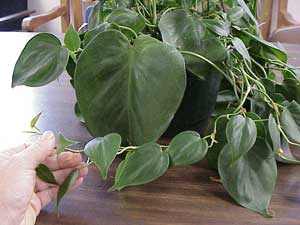Most leaves are sensitive to changes
in light levels. If you take a plant that’s been growing
in the shade and place it in bright sunlight, it can get "sunburned."
Plants growing in direct sun develop a tougher epidermis layer,
while plants growing in shade need to optimize their ability to
take in sunlight, and therefore have a thinner epidermis layer.
 Some plants adapt
to different light levels by modifying their new growth to suit
the new environment. A plant may alter its leaf size and even
color depending on light intensity and duration. For example,
the common philodendron houseplant tends to produce smaller
leaves and longer vines in dim light, and larger leaves on shorter
vines in bright light. On the other hand, a ficus tree brought
from direct sun into dim light will shed some of its old leaves
and begin to produce slightly larger, thinner leaves. Many variegated
plants like crotons and coleus will have more variegation in
brighter light. In most cases, the existing leaves don’t
change—only the new growth reflects the adaptations
to the new conditions.
Some plants adapt
to different light levels by modifying their new growth to suit
the new environment. A plant may alter its leaf size and even
color depending on light intensity and duration. For example,
the common philodendron houseplant tends to produce smaller
leaves and longer vines in dim light, and larger leaves on shorter
vines in bright light. On the other hand, a ficus tree brought
from direct sun into dim light will shed some of its old leaves
and begin to produce slightly larger, thinner leaves. Many variegated
plants like crotons and coleus will have more variegation in
brighter light. In most cases, the existing leaves don’t
change—only the new growth reflects the adaptations
to the new conditions.
|
|

Sunscreen Anyone?
Any time you
change a plant’s location, do so gradually, to give it time to adapt. Be sure to give
indoor-grown seedlings a hardening off period before setting them in the
garden. Acclimate them gradually by setting the seedlings in a protected spot outdoors for
a few hours the first day, then increasing the amount of time you leave the plants
outdoors over the course of a week or two. Use the same procedure if you bring houseplants
outdoors in the spring. |
|